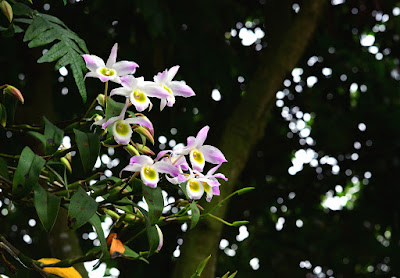Dendrobium findlayanum is native to Southeast Asia. In Myanmar, these plants are found from the regions near Tenasserim, Taunggyi and Inle Lake. Further this habitat extends through the mountains of northern Thailand to Laos.
Dendrobium findlayanum, also called as Findlay's Dendrobium (named to honor the English Collector in Borneo), Callista findlayana, Dendrobium findleyanum, is a species of the genus Dendrobium. This species was described by E.C.Parish & Rchb.f. in 1874.
IDENTIFY DENDROBIUM FINDLAYANUM
Dendrobium findlayanum is native to Southeast Asia. In Myanmar, these plants are found from the regions near Tenasserim, Taunggyi and Inle Lake. Further this habitat extends through the mountains of northern Thailand to Laos. Plants usually appear in mixed forests at heights of 1000-1700 m.
It is a medium to large sized, cool growing epiphytic, which reaching 38-70 cm in height, with compressed bilaterally, each node swollen, to 7 nodes, green turning yellow, to 22" (50 cm) long stems that are sulcate with age and carry deciduous, narrowly elliptic or lanceolate, acute, bright green, 8-10 cm long leaves.
Findlay's Dendrobium blooms in the winter and spring on a very short, axillary, racemose inflorescence that arises from the nodes near the apex of mature leafless canes with a few, long-lasting, color variable, fragrant flowers. The flowers are 5-8 cm in diameter. Thin paper flakes of both whorls, which often lean back, can be from pale to dark purple .The darkest shades are at the tops, and at the base are whitened. Gently mossy the lip may be creamy to orange-yellow or white with a pink tip. It is often dark yellow at the base with a violet or blackish-red spot that has pale margins. The cover of the anther chamber is white.
DENDROBIUM FINDLAYANUM CARE AND CULTURE
Cultural information should only be used as a guide, and should be to be adapted to suit you. Your physical location; where you grow your plants, how much time you have to devote to their care, and many other factors, will need to be taken into account. Only then can you decide on the cultural methods that best suit you and your plants.
Light:
Dendrobium findlayanum needs a light level of 20000-30000 lux, and shading is required from spring to autumn, but the light level should be as high as the plant can tolerates without burning leaves.
Temperature:
The average temperature of the day in summer is 25-26 ° C, the night 17-18 ° C, giving a daily difference of 7-8 ° C. In spring, the average day temperature is 29-31 ° C, night 11-18 ° C, giving a daily difference of 11-20 ° C. The average temperature of the winter day is 23-26 ° C, the night 8-9 ° C, which significantly increases the daily difference to 14-18 ° C.
Humidity:
Through summer and autumn, Findlay's Dendrobium needs the average humidity of 80-85%, but in winter it drops to 60-70%. Within 2 months at the beginning of spring the humidity drops to almost 50%.
Substrate, growing media and repotting:
Dendrobium findlayanum can be grown mounted on tree-fern rootstock or cork with high humidity and watering in summer at least once a day. If they are grown in pots, any loose, fast-drying substrate is recommended. Repotting is best done at the beginning of spring, immediately after flowering, when new roots begin to grow.
Watering:
In the growing season, watering is very abundant, but the winter is very dry. The plants should be constantly moist when they grow actively, and when in the autumn new increments reach maturity, the amount of water should be gradually reduced.
Fertilizer:
It is recommended to apply a 1/4-1/2 dose of orchid fertilizer weekly. It is preferable to use high-nitrogen fertilizer from spring to mid-summer, and then use high-phosphoric fertilizer until the end of autumn.
Rest period:
The amount of water should be reduced from the end of autumn to the beginning of spring. For most of winter, Dendrobium findlayanum should dry out between waterings, but they should not be completely dry for too long. Occasional morning fogging between waterings will help protect the plant from excessive drying. In the period of 1-2 months at the end of winter, however, the amount of water should be reduced to the occasional morning fogging. Fertilization should be reduced or eliminated until new increments appear in the spring.















Thank you
ReplyDeleteI'm having trouble with D.Findlay
Can you tell me something about your trouble! Maybe I can help you!
Delete